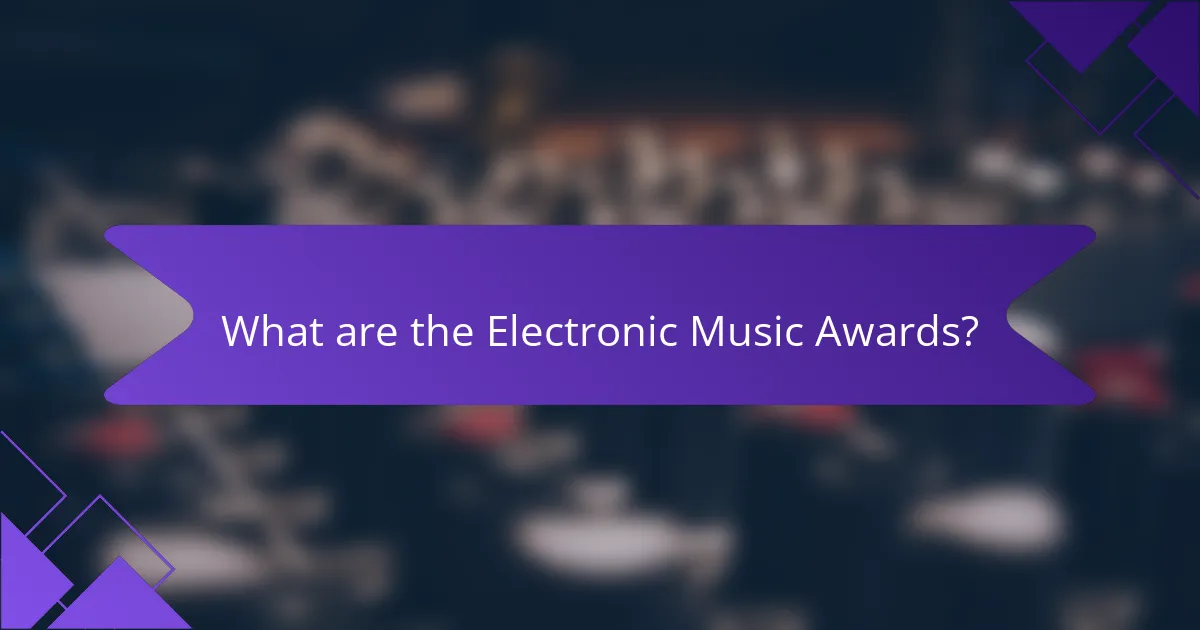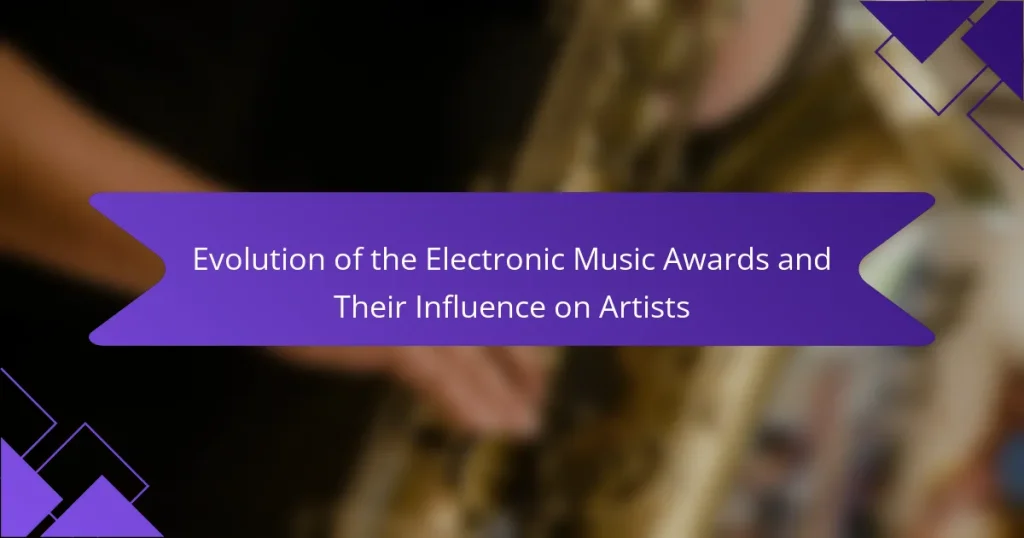The Electronic Music Awards (EMA) are an annual event that recognizes achievements in the electronic music genre, celebrating artists, producers, and tracks that have made significant contributions to the scene since their inception in 2017. The awards encompass various categories, such as Best Dance Record and Best DJ, and are determined through votes from both fans and industry professionals, fostering engagement within the community. The impact of the EMAs on artists includes enhanced credibility, increased media attention, and expanded networking opportunities, which can lead to collaborations and improved marketability. Looking ahead, the EMAs are set to evolve by incorporating emerging technologies and promoting inclusivity, ensuring their relevance in the ever-changing landscape of electronic music.

What are the Electronic Music Awards?
The Electronic Music Awards are an annual event recognizing achievements in electronic music. They celebrate various genres within the electronic music scene. The awards highlight artists, producers, and tracks that have made significant impacts. The inaugural ceremony took place in 2017. The event features multiple categories, including Best Dance Record and Best DJ. It aims to promote the electronic music community and its artists. The awards are voted on by both fans and industry professionals. This format fosters engagement and recognition within the electronic music landscape.
How did the Electronic Music Awards originate?
The Electronic Music Awards originated in 2016. They were created to recognize and celebrate achievements in electronic music. The awards aimed to honor artists, producers, and industry professionals. The inaugural event took place in Los Angeles. It featured performances by notable electronic artists. The awards were established to fill a gap in recognition for the electronic music genre. They also sought to engage a broader audience in the electronic music community. The Electronic Music Awards have since aimed to elevate the profile of electronic music globally.
What key milestones marked the inception of the Electronic Music Awards?
The key milestones that marked the inception of the Electronic Music Awards include its announcement in 2016. The event aimed to celebrate and recognize achievements in electronic music. The first awards ceremony took place in 2017. It featured various categories highlighting artists and producers. The event was also streamed online, reaching a global audience. The Electronic Music Awards aimed to fill a gap in recognition for electronic music. The ceremony included performances from notable electronic artists. These milestones established the foundation for the awards’ ongoing influence in the electronic music industry.
Who were the pioneering figures behind the Electronic Music Awards?
The pioneering figures behind the Electronic Music Awards include DJ and producer Paul Oakenfold and music executive and entrepreneur Michael B. The Electronic Music Awards were established to recognize achievements in electronic music. Paul Oakenfold is known for his influence in the genre and has a successful career as a DJ. Michael B played a significant role in the creation and promotion of the awards. Their collaboration helped to shape the direction of the awards and elevate the profile of electronic music artists. The inaugural ceremony took place in 2017, highlighting the importance of electronic music in the broader music industry.
What categories are included in the Electronic Music Awards?
The Electronic Music Awards include categories such as Best Electronic Album, Best Dance Song, and Best New Artist. Additional categories are Best DJ, Best Producer, and Best Live Act. These categories recognize achievements in various aspects of electronic music. The awards aim to honor both established and emerging talent in the industry. Each category is designed to celebrate different contributions to electronic music. The Electronic Music Awards have evolved to reflect the changing landscape of the genre. They highlight the diversity and innovation within electronic music.
What are the main award categories recognized in the Electronic Music Awards?
The main award categories recognized in the Electronic Music Awards include Best Electronic Album, Best Electronic Song, and Best DJ. Additional categories are Best New Artist and Best Live Performance. These categories aim to celebrate achievements within the electronic music genre. The awards highlight both established and emerging talent in the industry. The recognition of these categories reflects the growing influence of electronic music in popular culture. Each category serves to honor specific contributions to the genre.
How do these categories reflect the diversity of electronic music?
Electronic music categories reflect its diversity by encompassing various genres and styles. Each category represents distinct characteristics, such as tempo, instrumentation, and cultural influences. For example, genres like techno, house, and drum and bass demonstrate different rhythmic structures and production techniques. This variety allows for a wide range of artistic expression and audience engagement. Additionally, categories can highlight regional differences, showcasing local sounds and traditions. The existence of multiple awards for these categories further emphasizes the genre’s complexity and the recognition of diverse talent within the electronic music scene.
What has been the evolution of the Electronic Music Awards over time?
The Electronic Music Awards have evolved significantly since their inception in 2017. Initially, they aimed to celebrate electronic music artists and their contributions. The first event featured categories like Best Electronic Album and Best DJ. In 2018, the awards expanded to include more diverse categories and international artists.
The 2019 ceremony introduced fan voting, increasing audience engagement. In subsequent years, the awards faced challenges, including production delays and changes in leadership. Despite these challenges, the Electronic Music Awards continued to adapt, focusing on inclusivity and innovation.
By 2021, the awards had shifted to a virtual format due to the pandemic, reaching a wider audience online. The evolution reflects the changing landscape of the electronic music industry and the need for recognition of emerging talent.
How have the Electronic Music Awards changed since their inception?
The Electronic Music Awards have evolved significantly since their inception in 2016. Initially, the awards focused on recognizing electronic music artists and their contributions to the genre. Over the years, the format has expanded to include a wider range of categories. This includes best tracks, albums, and live performances.
The voting process has also changed, moving from industry-only votes to include fan voting. This shift has increased audience engagement and participation. Additionally, the awards have adapted to trends in the electronic music scene, reflecting changes in genres and popular artists.
The event has grown in scale, attracting larger audiences and more mainstream media coverage. This growth has enhanced the visibility of electronic music in the broader music industry. Overall, the Electronic Music Awards have become a more inclusive and representative platform for artists within the electronic music community.
What significant trends have influenced the evolution of the Electronic Music Awards?
The evolution of the Electronic Music Awards has been influenced by several significant trends. The rise of digital streaming platforms has transformed how music is consumed. This shift has increased visibility for electronic artists. Social media’s growth has allowed for direct engagement between artists and fans. Additionally, the globalization of music has expanded the reach of electronic genres. The incorporation of technology in performances has also shaped award categories. Furthermore, the increasing recognition of electronic music in mainstream media has elevated its status. These trends collectively reflect the changing landscape of the music industry.

How do the Electronic Music Awards influence artists?
The Electronic Music Awards influence artists by providing recognition and exposure. Winning or being nominated can enhance an artist’s credibility. This recognition often leads to increased media attention. Artists may experience growth in their fanbase as a result. The awards also offer networking opportunities within the industry. Collaborations often arise from connections made during the event. Additionally, the awards can impact an artist’s marketability. Successful nominees may secure better representation and booking opportunities.
What impact do the Electronic Music Awards have on an artist’s career?
The Electronic Music Awards significantly enhance an artist’s career. Winning or being nominated can increase visibility and credibility. Artists often gain access to larger audiences and industry connections. Recognition at these awards can lead to increased streaming and sales. Additionally, it can attract collaboration opportunities with other artists. Awards can also enhance an artist’s marketability to brands and sponsors. The event showcases emerging talents, providing a platform for new artists. Overall, the Electronic Music Awards serve as a catalyst for career growth in the electronic music industry.
How do awards recognition affect an artist’s visibility and opportunities?
Awards recognition significantly enhances an artist’s visibility and opportunities. Winning or being nominated for awards increases public awareness of the artist. This recognition often leads to media coverage and promotional opportunities. Artists may receive invitations to perform at prestigious events. Increased visibility can attract new fans and followers. Awards can also lead to collaborations with other artists and industry professionals. Furthermore, recognized artists may secure better contracts and higher fees. According to a study by the Music Industry Research Association, award-winning artists see a 30% increase in streaming and sales post-recognition.
What are the long-term benefits for artists who win or are nominated for awards?
Artists who win or are nominated for awards gain significant long-term benefits. These accolades enhance their visibility in the industry. Increased recognition often leads to more opportunities for collaborations. Winning awards can elevate an artist’s marketability and attract new fans. Financial gains may also occur through increased sales of music and merchandise. Awards can lead to invitations for high-profile performances and festivals. Additionally, they can provide validation and boost an artist’s confidence. A study by the University of Southern California found that Grammy winners experience a 30% increase in album sales post-award. This data supports the claim that awards have a lasting positive impact on artists’ careers.
How do the Electronic Music Awards shape industry standards?
The Electronic Music Awards shape industry standards by recognizing and promoting excellence in electronic music. This recognition creates benchmarks for quality and innovation within the genre. Awards influence artists to elevate their craft to meet these standards. They also encourage collaboration and experimentation among musicians. The visibility provided by the awards can lead to increased opportunities for artists. Additionally, the awards help to define categories and genres within electronic music. This classification aids in the organization of the industry and helps audiences navigate it. Overall, the Electronic Music Awards play a crucial role in establishing and maintaining industry standards.
What role do the awards play in setting benchmarks for quality in electronic music?
Awards in electronic music serve as critical benchmarks for quality. They recognize excellence in production, creativity, and innovation. By honoring artists and tracks, awards establish standards that others aspire to meet. This recognition often leads to increased visibility for winners. It encourages artists to elevate their work to compete for accolades. Awards also influence industry trends by highlighting emerging sounds and styles. For example, the Grammy Awards have categories specifically for electronic music, shaping public perception and market demand. Overall, awards significantly impact the quality and direction of electronic music.
How do the awards influence the direction of electronic music genres?
Awards influence the direction of electronic music genres by setting industry standards and recognizing innovation. They highlight emerging trends and popularize specific styles. For example, the Grammy Awards have introduced categories for electronic music, increasing visibility. This encourages artists to explore new sounds to compete. Awards also shape audience expectations and consumption patterns. Winning or being nominated can lead to increased sales and streaming. Moreover, awards often reflect and amplify cultural shifts within the genre. This feedback loop drives artists to adapt and evolve their music.
What are the criticisms and challenges faced by the Electronic Music Awards?
The Electronic Music Awards face several criticisms and challenges. Critics argue that the awards lack transparency in the nomination process. This has led to accusations of favoritism among nominees. Additionally, some artists feel underrepresented in the voting outcomes. The awards also struggle with maintaining relevance in a rapidly changing music landscape. There are concerns about the commercial influence overshadowing artistic merit. Furthermore, logistical issues often arise during the event organization. These challenges have been highlighted in various industry discussions and articles.
What common criticisms are directed at the Electronic Music Awards?
Common criticisms directed at the Electronic Music Awards include claims of lack of transparency. Critics argue that the voting process is not clear, leading to questions about legitimacy. Additionally, some believe the awards favor mainstream artists over underground talent. This perception can alienate emerging artists within the electronic music scene. There are also concerns about the overall relevance of the awards in a rapidly evolving genre. Critics suggest that the awards do not accurately reflect the diversity of the electronic music community. Furthermore, some feel that the event prioritizes spectacle over genuine recognition of artistic achievement. These criticisms highlight ongoing debates about the awards’ effectiveness and credibility within the industry.
How have the Electronic Music Awards responded to challenges in the industry?
The Electronic Music Awards have adapted to industry challenges by incorporating diverse genres and promoting inclusivity. They have expanded their categories to reflect the evolving landscape of electronic music. This includes recognizing emerging artists alongside established ones. The awards have also embraced digital platforms for wider accessibility and engagement. In response to the pandemic, they shifted to virtual events, maintaining audience interaction. Additionally, they have partnered with organizations to support mental health initiatives within the music community. These actions demonstrate their commitment to addressing industry challenges effectively.

What is the future of the Electronic Music Awards?
The future of the Electronic Music Awards (EMA) appears promising as they continue to evolve. The awards aim to adapt to the changing landscape of electronic music. Increased participation from diverse artists is likely to enhance their relevance. Emerging technologies, such as blockchain for voting, may be integrated. This could ensure transparency and security in the awards process. Additionally, collaborations with streaming platforms might expand their audience reach. The EMAs could also focus on inclusivity, recognizing a broader range of genres and styles. Overall, the EMAs are positioned to play a significant role in celebrating electronic music’s growth.
How might the Electronic Music Awards evolve in the coming years?
The Electronic Music Awards may evolve to incorporate more diverse genres and artists. This shift reflects the growing popularity of electronic music across various demographics. Additionally, the awards could expand their voting process to include fan participation, enhancing audience engagement. Technological advancements may lead to virtual or augmented reality experiences during the ceremonies. Increased collaboration with streaming platforms could also influence award categories and nominations. The integration of data analytics might provide insights into trends and audience preferences. Such changes are likely to enhance the relevance and appeal of the awards in a rapidly changing music landscape.
What trends could shape the future of the Electronic Music Awards?
Increased integration of technology will shape the future of the Electronic Music Awards. Virtual reality and augmented reality experiences are becoming more common in events. This trend enhances audience engagement and interaction. The rise of social media platforms is also influencing award nominations and voting processes. Artists are leveraging these platforms to connect with fans. Additionally, diversity and inclusion initiatives are gaining traction in the music industry. This shift encourages broader representation among nominees and winners. Sustainability practices are becoming essential in event planning. Awards that prioritize eco-friendly initiatives may attract more attention. Finally, collaborations between electronic music artists and mainstream musicians are likely to grow. These collaborations can elevate the visibility of the awards and expand their audience.
How could technological advancements impact the Electronic Music Awards?
Technological advancements could significantly enhance the Electronic Music Awards. Innovations in streaming technology allow for wider audience reach. Enhanced voting systems can increase engagement and participation. Virtual reality experiences could create immersive award shows. Data analytics can provide insights into audience preferences. Social media integration may boost real-time interaction during events. Blockchain technology could ensure transparency in voting processes. These advancements collectively elevate the overall experience for artists and fans alike.
What can artists do to leverage the Electronic Music Awards for their benefit?
Artists can leverage the Electronic Music Awards by increasing their visibility and networking opportunities. Participating in the awards can enhance their reputation within the industry. Winning or being nominated can lead to greater media exposure. This exposure can attract new fans and opportunities for collaborations. Artists should also engage with the audience during the event to build a stronger connection. Utilizing social media to promote their participation can further amplify their reach. The awards can serve as a platform for showcasing new music and talent. Additionally, artists can connect with industry professionals attending the event to explore potential partnerships.
What strategies can artists employ to increase their chances of winning an award?
Artists can increase their chances of winning an award by focusing on quality, networking, and strategic submissions. High-quality work stands out in competitions. Artists should continually improve their craft and seek feedback. Networking with industry professionals can lead to valuable recommendations. Attending events and engaging with peers enhances visibility. Strategic submissions involve researching the award criteria and tailoring entries accordingly. Artists should highlight unique aspects of their work that align with the award’s focus. Collaborating with other artists can also broaden appeal. Finally, maintaining an active online presence can attract attention from judges and voters.
How can artists use award nominations to enhance their brand and reach?
Artists can use award nominations to enhance their brand and reach by leveraging the recognition that comes with them. Award nominations increase visibility in the competitive music industry. They attract media attention, leading to interviews and features. This heightened exposure can result in a larger fanbase.
Additionally, nominations validate an artist’s work, establishing credibility. This credibility can open doors to collaborations and partnerships. Artists can also promote their nominations on social media, engaging with fans. According to a 2021 study, artists with award nominations saw a 30% increase in streaming numbers post-nomination.
Overall, award nominations serve as a powerful marketing tool for artists.
The Electronic Music Awards (EMA) are an annual event that recognizes achievements in the electronic music genre, celebrating artists, producers, and tracks across various categories such as Best DJ and Best Electronic Album. Established in 2016, the awards have evolved to include fan voting and a broader range of categories, reflecting the diversity and innovation within electronic music. The EMA significantly influence artists’ careers by enhancing visibility, credibility, and networking opportunities, while also shaping industry standards and trends. Despite facing challenges and criticisms regarding transparency and representation, the awards continue to adapt and expand their relevance in the rapidly changing music landscape.


